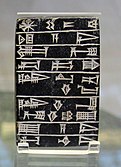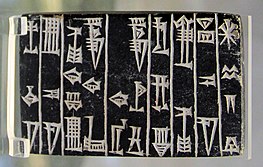Nimintabba
DNimintabba.............. "For Nimintabba"
NIN-a-ni..................... "his Lady,"
SHUL-GI.................... "Shulgi"
NITAH KALAG ga...... "the mighty man"
LUGAL URIM KI ma... "King of Ur"
LUGAL ki en............... "King of Sumer"
gi ki URI ke................. "and Akkad,"
E a ni.......................... "her Temple"
mu na DU................... "he built"[3]
NIN-a-ni..................... "his Lady,"
SHUL-GI.................... "Shulgi"
NITAH KALAG ga...... "the mighty man"
LUGAL URIM KI ma... "King of Ur"
LUGAL ki en............... "King of Sumer"
gi ki URI ke................. "and Akkad,"
E a ni.......................... "her Temple"
mu na DU................... "he built"[3]
Foundation tablet of king Shulgi (c. 2094–2047 BC), for the Temple of Nimintabba in Ur. ME 118560 British Museum.[1][2] Inscription "For his Lady Nimintabba, Shulgi the mighty man, King of Ur and King of Sumer and Akkad, has built her Temple":[3] The traditional orientation is vertical, but modern transcription is based on the rotated script.
Location of the Nimintabba Temple in Ur.
Nimintabba (𒀭𒐏𒋰𒁀 DNimin-tab-ba, previously read Dimtabba) was a Goddess of Sumer.[4] She is thought to have been a local deity of the city of Ur, as her only known temple was located there. Her worship was particularly associated with king Shulgi (reigned c. 2094 – c. 2046 BC), and there are no previous attestations of her.
- ^ "Nimintabba tablet". British Museum.
- ^ Enderwitz, Susanne; Sauer, Rebecca (2015). Communication and Materiality: Written and Unwritten Communication in Pre-Modern Societies. Walter de Gruyter GmbH & Co KG. p. 28. ISBN 978-3-11-041300-7.
- ^ a b "(For the goddess) Nimintabba, his lady, Shulgi, mighty man, king of Ur, king of Sumer and Akkad, her house, built." in Expedition. University Museum of the University of Pennsylvania. 1986. p. 30.
- ^ "Another little-known deity is Nimintabba. This goddess had a small temple in the city of Ur, built on the orders of king Shulgi..." in Toorn, K. Van Der (1996). Family Religion in Babylonia, Ugarit and Israel: Continuity and Changes in the Forms of Religious Life. BRILL. p. 83. ISBN 978-90-04-10410-5.


